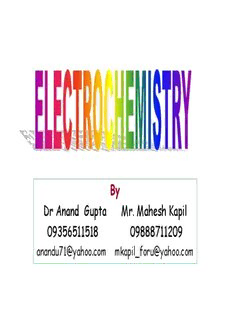
Dr Anand Gupta Mr. Mahesh Kapil Dr. Anand Gupta PDF
Preview Dr Anand Gupta Mr. Mahesh Kapil Dr. Anand Gupta
BByy Dr Anand Gupta Mr. Mahesh Kapil Dr. Anand Gupta 09356511518 09888711209 [email protected] [email protected] Electrochemistry EElleeccttrroollyyssiiss Electric energy Chemical energy GGaallvvaanniicc cceellll 2 Electrochemistry The study of the interchange of chemical and electrical energy. Chemical Energy Electrical energy I: A science studying the relationship between chemical energy and electrical energy and the rules of conversion of two energies. II: Electrochemistry is the study of solutions of electrolytes and of phenomena occurring at . electrodes immersed in these solutions EEEllleeeccctttrrrooonnn TTTrrraaannnsssfffeeerrr RRReeeaaaccctttiiiooonnnsss (cid:1)Electron transfer reactions are oxidation-reduction or Redox reactions. (cid:1)Results in the generation of an electric current (electricity) or be caused by imposing an electric current. (cid:1)Therefore, this field of chemistry is often called ELECTROCHEMISTRY. 4 Electrochemical processes are oxidation-reduction reactions in which: • the energy released by a spontaneous reaction is converted to electricity or • electrical energy is used to cause a nonspontaneous reaction to occur 0 0 2+ 2- 2Mg (s) + O (g) 2MgO (s) 2 2Mg 2Mg2+ + 4e- Oxidation half-reaction (lose e-) O + 4e- 2O2- Reduction half-reaction (gain e-) 2 5 TTTeeerrrmmmiiinnnooolllooogggyyy fffooorrr RRReeedddoooxxxRRReeeaaaccctttiiiooonnnsss (cid:1)(cid:1)OOXXIIDDAATTIIOONN——lloossss ooff eelleeccttrroonn((ss)) bbyy aa ssppeecciieess;; (cid:1)OXIDATION—loss of electron(s) by a species; iinnccrreeaassee iinn ooxxiiddaattiioonn nnuummbbeerr;; iinnccrreeaassee iinn ooxxyyggeenn.. increase in oxidation number; increase in oxygen. (cid:1)(cid:1)RREEDDUUCCTTIIOONN——ggaaiinn ooff eelleeccttrroonn((ss));; ddeeccrreeaassee iinn (cid:1)REDUCTION—gain of electron(s); decrease in ooxxiiddaattiioonn nnuummbbeerr;; ddeeccrreeaassee iinn ooxxyyggeenn;; iinnccrreeaassee iinn oxidation number; decrease in oxygen; increase in hhyyddrrooggeenn.. hydrogen. (cid:1)(cid:1)OOXXIIDDIIZZIINNGG AAGGEENNTT——eelleeccttrroonn aacccceeppttoorr;; ssppeecciieess iiss (cid:1)OXIDIZING AGENT—electron acceptor; species is rreedduucceedd.. ((aann aaggeenntt ffaacciilliittaatteess ssoommeetthhiinngg;; eexx.. TTrraavveell reduced. (an agent facilitates something; ex. Travel aaggeennttss ddoonn’’tt ttrraavveell,, tthheeyy ffaacciilliittaattee ttrraavveell)) agents don’t travel, they facilitate travel) (cid:1)(cid:1)RREEDDUUCCIINNGG AAGGEENNTT——eelleeccttrroonn ddoonnoorr;; ssppeecciieess iiss (cid:1)REDUCING AGENT—electron donor; species is ooxxiiddiizzeedd.. oxidized. 6 Another way to remember (cid:1) OILRIG ee xx ss oo ss aa dd ii ss ii uu dd ee nn cc aa tt tt ii ii oo oo nn nn 7 Review of Oxidation numbers The charge the atom would have in a molecule (or an ionic compound) if electrons were completely transferred. 1. Free elements (uncombined state) have an oxidation number of zero. Na, Be, K, Pb, H , O , P = 0 2 2 4 2. In monatomic ions, the oxidation number is equal to the charge on the ion. Li+, Li = +1; Fe3+, Fe = +3; O2-, O = -2 3. The oxidation number of oxygen is usually –2. In H O 2 2 and O 2- it is –1. 2 8 4. The oxidation number of hydrogen is +1 except when it is bonded to metals in binary compounds. In these cases, its oxidation number is –1. 5. Group IA metals are +1, IIA metals are +2 and fluorine is always –1. 6. The sum of the oxidation numbers of all the atoms in a molecule or ion is equal to the charge on the molecule or ion. HCO - 3 Oxidation numbers of all O = -2 H = +1 the atoms in HCO - ? 3 3x(-2) + 1 + ? = -1 C = +4 9 Galvanic Cells anode cathode oxidation reduction - + spontaneous redox reaction 10
Description: